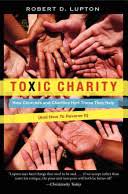Book Review: Toxic Charity

When I began work at the Indiana Philanthropy Alliance in April, my supervisor handed me a copy of Toxic Charity: How Churches and Charities Hurt Those They Help (And How To Reverse It), and suggested that my first step might be to read the book we were going to be discussing during our Regional Forums, which took place this week all over Indiana. This book had made the rounds of my previous communities in the faith-based sector, and I was glad to have an excuse to read it. Before I was two chapters in, I found myself wishing I’d read it sooner.
Bob Lupton (Founder, FCS Urban Ministries; PhD) has created an accessible, provocative, convincing little argument in this book: namely, that heartfelt, well-meant expressions of helping often end up disempowering and disenfranchising the very people they’re meant to serve. In other words, well-meant charity can be toxic, a source of poison that progressively kills the health of a community. From the perspective of an experienced and successful community developer, he fleshes this out with compelling examples and stories from his own work in inner-city Atlanta. And he proposes what he calls an “oath of service,” borrowing conceptually from the Hippocratic Oath to ask people in helping professions to commit to a series of promises. Here it is, taken directly from the FCS website:
1. I will never do for others what they have (or could have) the capacity to do for themselves.
2. I will limit my one-way giving to emergency situations and seek always to find ways and means for legitimate exchange.
3. I will seek ways empower the poor through hiring, lending and investing and use grants sparingly as incentives that reinforce achievements.
4. I will put the interests of the poor above my own (or organizational) self-interest even when it may be costly.
5. I will take time to listen and carefully assess both expressed and unspoken needs so that my actions will ultimately strengthen rather than weaken the hand of those I would serve.
6. Above all, to the best of my ability, I will do no harm.
As you might imagine, some of the examples of charity gone toxic are wince-worthy - not least because many of us in helping professions can remember blithely running programs that qualify for toxicity labeling. But Bob, both in his book and in person, has a gift for defusing defensiveness, and once you can catch the vision he describes, a vision of a community in which all the members are empowered to be contributing neighbors, it’s easy to get excited.
The challenge here is that the work is slow. It requires a shift in perspective. It’s much easier to hold a food drive - and to sell a board and investors on the results of that food drive - than it is to engage in the messier, more complicated work of developing a stable food co-op. It’s much easier to fund and coordinate a weekend backpack food program than it is to find out which children are hungry on the weekends, find out why they’re hungry, and figure out a systemic and responsible approach to changing the underlying situation.
At our Regional Forums, we knew many people had been introduced to these concepts, but had struggled to figure out how to put them into action in their own contexts. So after Bob spoke and answered questions, we tried to create space for a deeper conversation about implementation. We created 5 case studies, based on actual nonprofit experience: a food pantry, a free health clinic, a corporate partnership with an arts organization, a scholarship program, and a Christmas giving program. And our attendees, a mixture of foundation and nonprofit professionals, worked together to “detoxify” these case studies.
We then asked people to group together - either based on geography and existing partnerships, or based topically on things like communication strategies, the challenge of implementing these ideas in a rural environment as opposed to an urban community, and the tension between crisis care and the longer process of developing human capacity. And in these groups, those deeper concretizing conversations could begin and continue.
It’s a tough question. At first read, Toxic Charity’s principles seem simple. But precisely because every community, every program, every leader is unique, finding ways to detoxify our helping practices is an individualized and complex process. It’s worth doing, however..before we expend all our energy and sincere passion inadvertently creating more problems than we solve.
